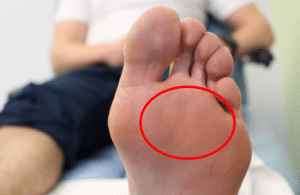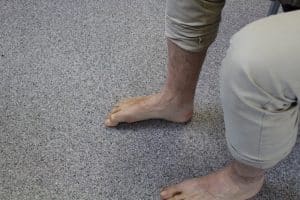What is Metatarsalgia?
Pain in the ball of the forefoot which can be spread over a large area or more focal. Generally, patients find their foot hurts at the point where there is pressure from weight bearing.
Pain in the ball of the forefoot which can be spread over a large area or more focal. Generally, patients find their foot hurts at the point where there is pressure from weight bearing.
It can because by injury, badly fitting footwear, overload from standing for long periods, exercise, over-use injury or being overweight. Bunions, hammer toes, neuroma and arthritis of the forefoot can cause metatarsalgia symptoms as well. A high- heeled shoe for example, will place more pressure on the front of the foot.
Natural padding under the ball of the foot can decrease with age creating a bonier, harder feel with less natural foot padding. This can lead to callus and corns which in turn can make the foot more uncomfortable.

It ranges from an ache and a bruise feeling to a sharper painful discomfort. Metatarsalgia is a generalised forefoot pain so can present in different ways.
Callus can be filed with an emery board, and applying moisturiser is advised. Corn treatment be done by a foot health practitioner, chiropodist, or podiatrist. These treatments are not provided by the NHS unless there is a high risk to foot need i.e., peripheral arterial disease.
Royal College of Podiatry (rcpod.org.uk)
Find a Podiatrist (rcpod.org.uk)
Leaflet: Self-care: how to find a Chiropodist/ Podiatrist – Sirona care & health (sirona-cic.org.uk)
If you have put on weight or are considered over-weight than this might be impacting your foot symptoms. Eating a healthy diet or following a weight loss programme might help reduce your foot pain in the long term.
See our “Healthy Living” section for more information on local healthy weight services
A reduction in impact activities might help reduce your symptoms or even simply wearing a cushioned shoe around the house as pressure can be an aggravator.
A decent cushioned-sole shoe/trainer that is not easily compressed under the ball of the foot is important. A cushioned thick sole with a curved front rocker can help forefoot symptoms. This allows recovery and forefoot propulsion, but it needs to be cushioned and stable- avoid overly flexible shoes. A removable insole is ideal if you need to use foot orthotics. Look for shoes with an appropriate width at the toe box avoiding tight shoes or stiff side materials over the big toe joint.
Over the counter painkillers like paracetamol or ibuprofen will ease the pain, but need to be taken regularly in order to control the pain. Follow the instructions on the packet and discuss using them safely with a pharmacist or GP, especially if you have any underlying health conditions.
https://www.nhs.uk/medicines/paracetamol-for-adults/
https://www.nhs.uk/medicines/ibuprofen-for-adults/
Adding cushioning under the ball of the foot can help with symptoms – these are known as metatarsal straps. A metatarsal strap/sleeve goes over the front of the foot offering gel padding for comfort.
Pro11 Gel Metatarsal Pads – ShoeInsoles.co.uk
Pro11 Ball of Foot Fabric Support with Gel Pad (Pair) – ShoeInsoles.co.uk
Metatarsal Pads/domes (made out of foam or fabric) can also be stuck onto the insole inside your shoes. These pads are often stuck just behind the ball of the foot- to deflect pressure and splay the foot. These can work well for many neuroma cases but you may find the pad an awkward object under your foot and prefer to use cushioning.
Pedag T Form Metatarsal Supports – ShoeInsoles.co.uk
Pedag Drop Metatarsal Supports – ShoeInsoles.co.uk
Podotech Polyurethane Metatarsal Pads – ShoeInsoles.co.uk
Basic Metatarsal Domes – ShoeInsoles.co.uk
https://www.shoeinsoles.co.uk/pedag-t-form-metatarsal-supports.html
metatarsal dome placement – how to do it your self – YouTube
An insole or foot orthotic can help reduce pressure with cushioning materials or firmer materials that offer structural support. It is not one-size-fits-all, sometimes a cushioned insole is suitable with small metatarsal pad whereas some feet benefit from a more substantial arch support.
The aim of foot exercises is to help reduce symptoms of the forefoot by engaging the mobility of the forefoot joints and strengthening the intrinsic foot muscles to provide stability when you are putting weight on the front of your foot.

If you prefer to stretch your calf muscles whilst seated, you can use a towel or a belt to stretch your calf muscle.

Contact your general practice if you need further help and guidance, a referral to local musculoskeletal services is required in some instances, and they can advise on appropriate treatment or pathways suitable to you.
Back to Foot & Ankle